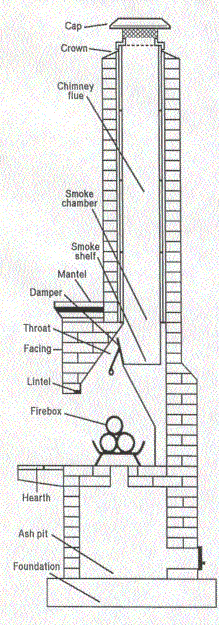Chimney sweeping in Wallkill, NY, are not exclusive to fireplace/woodstove chimneys. Have your oil/gas flues chimney maintenance regularly as well. Contact us today!
|
For information on any chimney part, point to its name. If the arrow turns into a hand, you can click for even more information.
- Metal, stone or clay structure intended to keep out rain, snow, leaves, animals, etc.
- Tapered concrete or mortar. Aids in keeping water off the top of the chimney structure. Without this, freeze-thaw damage can occur.
- Clay, ceramic or metal conduit in a chimney intended to contain the combustion products and to protect the chimney shell from heat and corrosion.
- Acts as a funnel to compress the smoke and gases from the fire so that they will squeeze into the chimney flue above.
- The smoke shelf is located behind the damper.
- A decorative surround around the fireplace opening.
- Regulates the draft and air passing from the firebox into the smoke chamber. Top sealing dampers are located at the top of the chimney under the rain cap or by themselves.
- The rectangular opening just before the damper.
- The area above the lintel also called the chimney breast.
- The supporting member of the fireplace opening, the lintel is made of angle iron.
- The area where the fire is burned; generally built of firebrick. This area can be made of metal as in a 'Steel Fireplace Unit'.
- Composed of the firebox floor and the hearth extension (the part of the fireplace that extends out past the fireplace opening).
- A non-combustible storage area into which the ashes are dumped.
- Foundation should be adequate to support load without settling.
|
 |
Chimney Maintenance
Maintenance plays a crucial role in a properly functioning chimney. A professional chimney sweep is trained not only to remove creosote build-up, but to thoroughly examine the entire system. Our Hickory Mountain sweeps also perform an NFPA 211 Level I inspection with every sweep. Below is a list of some of the things your professional chimney sweep looks for during a chimney inspection, from top to bottom:
- We check to be sure the chimney has a chimney cap or rain cover. This cap should be removable to allow for flue cleaning.
- The crown is checked for signs of deterioration.
- We examine the flashing. Oftentimes this is the source of any leaking.
- The exterior of the chimney is checked for any signs of deterioration, such as missing mortar, cracks in the mortar or other masonry, loose or missing bricks, etc.
- The flue liner is closely examined. Clay tiles are checked for proper installation and any deterioration.
- Flue connections are examined to be sure they are properly sized and installed.
- The smoke chamber is inspected for signs of deterioration. It should be relatively smooth on the inside to properly vent smoke and creosote.
- Dampers are tested for proper operation.
- The firebox is checked for signs of deterioration.
- We make sure grates, doors and screens are in place and in good repair.
- The hearth is checked for clearance to combustibles. In fact, this is a critical issue throughout the venting system.
- We follow NFPA 211 code guidelines and recommend procedures to make your system meet these code standards.
Click here for current pricing.